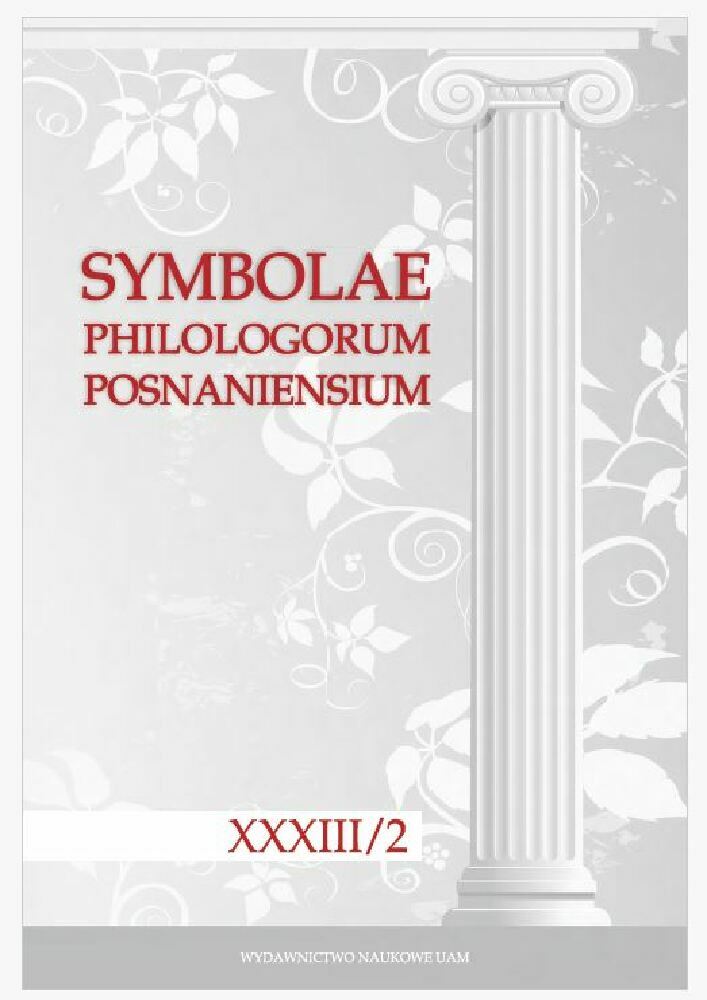Abstrakt
This article discusses style in Plautus. In order to do so objectively, we need to look at distribution patterns; a phenomenon can be considered poetic or colloquial if (a) it is restricted to poetry or comedy, (b) a parallel corpus of the same time period has an equivalent expression, and (c) this distribution is statistically significant. The main problem with applying such an approach to Plautus is that he makes up 60% of early Latin (with Terence giving us another 15%); other texts are not always suitable for comparison: inscriptions may be short, highly formal, or hard to date, Cato’s work on agriculture is extremely technical, and fragments of early drama are often quoted by grammarians who are more interested in what is possible than in what is normal. However, we can compare Plautus with Plautus, insofar as we can compare different stock characters, different metres, or different sub-genres within comedy.
Loss of final –s and iambic shortening seem to more common in colloquial passages, with a preponderance in iambic lines, a smaller number in long verses, and the smallest number in polymetric song. Within morphology, subjunctives of the type siem and mediopassive infinitives ending in –ier are strongly preferred at line end, out of metrical convenience; they are already archaic in Plautus, but still employed so frequently that not every individual instance is stylistically significant. Pronominal accusative and ablative forms like med and ted are also already old-fashioned and used mostly for metrical reasons; they, too, occur so commonly that not every instance is significant. Other morphological features look archaic from a classical perspective, but are still normal in Plautus; this is the case for the second-person medio-passive ending –re and the fourth-conjugation imperfect in –ibam. Genitive plural forms of the second declension mostly end in –orum; the older –um is largely restricted to fixed collocations, which are presumably stylistically unmarked.
On the other hand, disyllabic genitive endings of the first declension (type familiai) were already archaic in Plautus’ day; they are rare and thus always used for stylistic effect. Within syntax, not all features that have traditionally been described as colloquial really do form part of a lower register. The ellipsis of subject accusatives in the accusative-and infinitive construction is driven by pragmatic and morphosyntactic factors rather than by stylistic considerations. Sentence length and complexity is lower in Plautus than in classical prose, but this is a feature of spoken language rather than of lower register. And finally, outside some common collocations, the ablative absolute is restricted to specific high-register contexts, such as prayers or battle reports.
When Plautus wants to be colloquial, he can use features from phonology to syntax, but when he wants to sound archaic, he limits himself to morphology (and lexical features). This should not come as a surprise: Plautus had access to colloquial language on a daily basis, but would encounter archaic texts mostly in written form; here, morphological and lexical features are the ones which are most noticeable and easiest to imitate.
Bibliografia
de Melo 2006: W.D.C. de Melo, If in Doubt, Leave It In: Subject Accusatives in Plautus and Terence, ‘Oxford University Working Papers in Linguistics, Philology & Phonetics’ XI (2006), 5–20.
de Melo 2007a: W.D.C. de Melo, Zur Sprache der republikanischen carmina Latina epigraphica: Satzumfang, Satzkomplexität und Diathesenwahl, in: Die metrischen Inschriften der römischen Republik, ed. by P. Kruschwitz, Berlin 2007, 97–120. DOI: https://doi.org/10.1515/9783110204292.1.97
de Melo 2007b: W.D.C. de Melo, The Present Tense with Future Meaning in the Accusative and Infinitive Construction in Plautus and Terence, ‘Transactions of the Philological Society’ CV (2007), 105–25. DOI: https://doi.org/10.1111/j.1467-968X.2007.00185.x
de Melo 2009: W.D.C. de Melo, Scies (Mil. 520) e scibis (Mil. 1365): Variazione accidentale?, in: Lecturae Plautinae Sarsinates XII: Miles gloriosus (Sarsina, 27 settembre 2008), ed. by R. Raffaelli and A. Tontini, Urbino 2009, 41–52.
de Melo 2011–13: W.D.C. de Melo, Plautus, 5 vols., Loeb Classical Library, Cambridge MA and London 2011–13.
de Melo 2023: W.D.C. de Melo, Morphology and Syntax, in: Early Latin: Constructs, Diversity, Reception, ed. by J.N. Adams, A. Chahoud, G. Pezzini, and C. Kerrigan, Cambridge 2023, 100–17. DOI: https://doi.org/10.1017/9781108671132.008
Dressler 1973: W. Dressler, Pour une stylistique phonologique du latin à propos des styles négligents d’une langue morte, ‘Bulletin de la Société de Linguistique de Paris’ LXVIII (1973), 129–45.
Fattori 2022: M. Fattori, Studi su accento e correptio iambica, Bologna 2022.
Fortson IV 2012: B.W. Fortson IV, Latin -rier and Its Indo-Iranian Congeners, ‘Indogermanische Forschungen’ CXVII (2012), 75–118. DOI: https://doi.org/10.1515/indo.2012.117.2012.75
Hine 2005: H.M. Hine, Poetic Influence on Prose: The Case of the Younger Seneca, in: Aspects of the Language of Latin Prose, ed. by T. Reinhardt, M. Lapidge, and J.N. Adams, Oxford 2005, 211–37. DOI: https://doi.org/10.5871/bacad/9780197263327.003.0010
Meiser 1998: G. Meiser, Historische Laut- und Formenlehre der lateinischen Sprache, Darmstadt 1998.
Questa 2007: C. Questa, La metrica di Plauto e di Terenzio, Urbino 2007.
Sjögren 1906: H. Sjögren, Zum Gebrauch des Futurums im Altlateinischen, Uppsala and Leipzig 1906.
Wallace 1982: R.E. Wallace, A Note on the Phonostylistics of Latin: (s) in Plautus, ‘Glotta’ LX (1982), 120–4.
Licencja
Prawa autorskie (c) 2023 Wolfgang David Cirilo de Melo

Utwór dostępny jest na licencji Creative Commons Uznanie autorstwa 4.0 Międzynarodowe.

